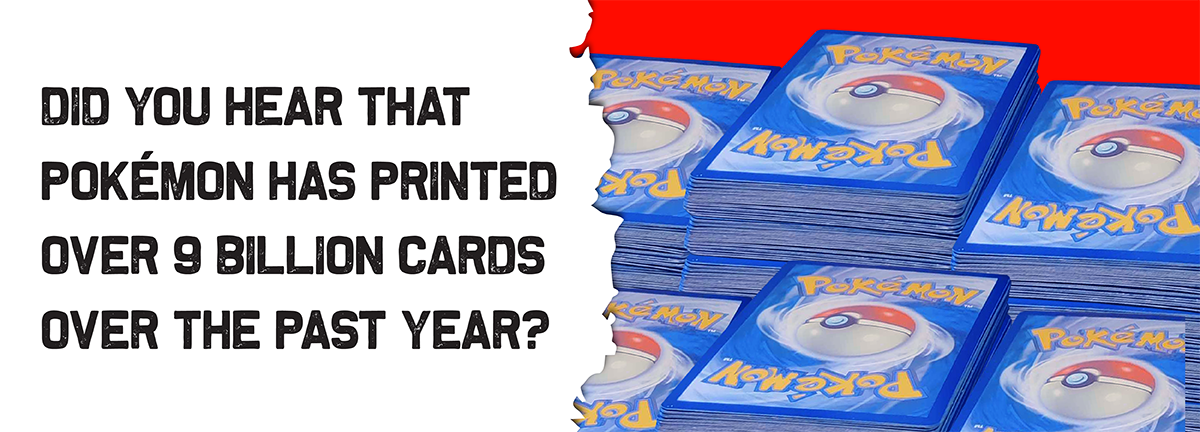Vincent Pontorno
Did you hear that Pokémon has printed over 9 billion cards over the past year?
You may have noticed that there are fewer Pokémon card packs in stock on store shelves. Since the beginning, Pokémon’s Supply has always kept pace with the demand. Still, it seems that retailers have too much of one and not enough of the other, which has caused problems for everyone all around.
So, in order to account for this historic rising demand, Pokémon has chosen to fix the problem by simply printing more cards than ever before. Pokémon typically prints anywhere from 1 to 2 billion cards every year. Production escalated last year to over 3 billion. Here we are in 2022 and Pokémon has gone all out by printing an all-time high of over 9 billion cards.
According to numerous sources and experts in the TCG community, this massive increase in production/printing has shown positive results thus far. By flooding the market and over-compensating for the increased demand, Pokémon can potentially see an increase in its stock.
You have to hand it to them, Pokémon saw a problem and took significant action to solve it. Now the question is: Will printing 9 billion cards be the new normal to ensure that their supply never drops below the demand again? And the other question is: What are the possible pitfalls of printing so many more cards in a given year? We asked our own Trainers/collectors here at Team Inked and Kraken cards to weigh in and give their thoughts on the matter.
According to one of our team members, Pokémon ‘recently’ acquired their own printing company to work alongside the three or four other printing companies that they’re currently in partnership with. Having this many cooks in the kitchen, so to speak, can be quite problematic, especially since each one uses a different printing method. From there, quality control becomes a key issue that can lead to negative results, such as:
- Foiling can look significantly different
- The formula for the card stock is often VASTLY different
- The thickness of the cards can vary
With that in mind, you can imagine the inconsistencies that have been discovered by both buyers and sellers when the cards/packs hit stores. So, by churning out such a massive amount of cards in a given year, it’s fair to assume that the quality will continue to suffer, and possibly decline even further. Our Kraken team members have also suggested that this increase in printing and lack of quality can also have a negative impact on pricing.
They were quoted as saying:
“We saw this effect pricing in Magic, with things like the Japanese Alternate Art Planeswalkers in War of the Spark. People wanted the ones from the Set Boosters instead of the Collector Boosters (they were printed in two different countries). This caused a weird arms race, and you can still see that on some things like the Strixhaven JP Alt Arts. This also happened with Kaladesh Inventions. Granted, the main difference was foiling, not card stock/size.”
While it’s true that this method of printing (or overprinting, if you see it that way) led to a significant increase in supply, it also led to Magic severely overshooting the demand. It’s not entirely certain if this is what will happen in Pokémon’s case, but based on previous results from other TCGs, it is something that must be considered.
The bottom line here is that they could be sacrificing quality for quantity. Sure, they’ll have more cards on the market, but if supply (and pricing) increases and the quality decreases, it could spell disaster in the year ahead. If you set the quality of the cards aside, there’s also the matter of the actual cards that you will find in each pack to think about as well.
Another Kraken team member also points out that this could lower the rarity of the bigger “pulls” causing the collector market to take a significant hit. “There are usually only 2-3 chase cards, and the rest bring almost no value at all.”
Now, one could argue that printing more cards could fix Pokémon’s problem and even possibly give them a much-needed boost. Again, there is evidence to suggest this outcome. However, there is also evidence to suggest the opposite. That said, we would really like to hear your thoughts on the subject and what you think the outcome will be 6-12 months from now. We’re not picking a side, but just simply offering insights from both, based on our first-hand experience with similar scenarios.
Feel free to sound off in the comments below and let us know what you think of Pokémon’s plans moving forward!
Best,
Inked Gaming



0 Comments